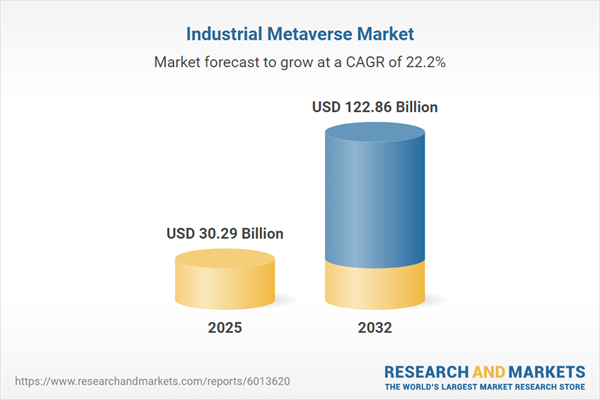Speak directly to the analyst to clarify any post sales queries you may have.
The industrial metaverse market is driving a new phase of enterprise digitalization, blending physical operations with virtual capabilities to power data-driven decision-making and foster agile business models.
Market Snapshot: Industrial Metaverse Market Expansion
The industrial metaverse market is experiencing accelerated growth, driven by rapid adoption in manufacturing, energy, and construction. Organizations leverage immersive technologies such as augmented reality and virtual reality to overcome operational barriers and modernize legacy processes. This evolution is strengthening collaboration among distributed teams and shaping adaptive responses to changing regulations and technological advancements. As enterprises invest in digital transformation, the resulting environment encourages continuous innovation, improved risk management, and resilience across complex industrial value chains. Digital modernization is reaching both mature and developing sectors, laying the groundwork for sustained operational efficiency and competitive differentiation.
Scope & Segmentation of the Industrial Metaverse Market
This report is designed for executives managing digital transformation and technology investments, offering a strategic overview of core market segments and their organizational relevance:
- Hardware: AR and VR headsets, advanced sensors, robust networking infrastructure, controllers, servers, and reliable data storage form the technological foundation for industrial metaverse adoption, helping to boost safety and operational efficiency in challenging environments.
- Services: Consulting, seamless integration, deployment assistance, ongoing maintenance, and targeted workforce training all contribute to successful technology rollouts and lasting adoption at the enterprise level.
- Software: Industry-focused platforms and digital tools enable workflow automation, facilitate integration, and manage transformation programs, empowering organizations to stay ahead of evolving digital landscapes.
- Enabling Technologies: 5G, AI analytics, digital twins, cloud computing, IoT integration, and specialized AR/VR infrastructure support real-time collaboration and ensure precise, automated processes across industrial operations.
- Key Verticals: Automotive, energy, construction, utilities, oil and gas, manufacturing, and healthcare each deploy metaverse strategies that address sector-specific objectives, innovation mandates, and regulatory complexities.
- Deployment Models: Cloud-based (hybrid, public, private), edge, on-premises, and regional data center solutions enable tailored responses to data sovereignty, security, and compliance requirements.
- Enterprise Scale: Large enterprises pursue broad-scale transformation, while small and medium-sized businesses seek digital solutions aligned with their resource allocations and operational needs.
- Regional Scope: The Americas, EMEA, and Asia-Pacific showcase unique drivers, regulatory contexts, talent pools, and technology adoption patterns, influencing market evolution and investment priorities.
- Leading Providers: Microsoft, NVIDIA, Siemens, PTC, Dassault Systèmes, Autodesk, Unity Software, ABB, IBM, and SAP play pivotal roles in shaping sector standards and guiding strategic choices within the industrial metaverse market.
Key Takeaways for Senior Decision-Makers
- Integrate digital platforms to enable real-time coordination, uniting teams and systems across geographic boundaries and streamlining complex workflows.
- Use modular technology strategies to increase agility and ensure smooth compliance with shifting regulations and operational risk considerations.
- Leverage AR, VR, AI, and IoT to drive predictive maintenance, provide remote operational support, and reinforce workforce safety standards.
- Tailor deployment strategies by region, with North America and Asia-Pacific concentrating on cloud adoption, while EMEA and Latin America focus on addressing workforce and industry-related complexities.
- Encourage partnerships and promote open standards to support regulatory compliance and seamless technology integration across broad ecosystems.
- Implement digital twins and edge computing for improved risk management, advanced simulation capabilities, and sustained performance in mission-critical functions.
Tariff Impact on the Industrial Metaverse Value Chain
Recent shifts in United States tariff policies are impacting the cost structures throughout the industrial metaverse supply chain. Enterprises and technology providers are re-evaluating sourcing strategies, prioritizing local production, and updating logistics to manage hardware pricing volatility and access specialized components. Solution providers now focus on delivering interoperable and adaptable tools, enabling nearshoring and helping businesses maintain stable operations amid global trade changes.
Methodology & Data Sources
This report’s insights derive from comprehensive secondary research, direct interviews with industry leaders, and proprietary analytics. Feedback from domain experts ensures senior executives access validated intelligence to navigate digital strategy and investment in the industrial metaverse.
Why This Report Matters
- Delivers data-driven benchmarking and detailed market analysis, supporting effective digital transformation and operational risk management.
- Offers actionable guidance for investment planning and alignment with modernization and compliance initiatives to ensure competitive progress.
- Enables senior leaders to make informed technology decisions in complex and evolving industrial environments.
Conclusion
This report empowers executive teams to anticipate technological change, direct enterprise modernization, and craft resilient strategies that underpin long-term value within the industrial metaverse market.
Additional Product Information:
- Purchase of this report includes 1 year online access with quarterly updates.
- This report can be updated on request. Please contact our Customer Experience team using the Ask a Question widget on our website.
Table of Contents
3. Executive Summary
4. Market Overview
7. Cumulative Impact of Artificial Intelligence 2025
Companies Mentioned
The companies profiled in this Industrial Metaverse market report include:- Microsoft Corporation
- NVIDIA Corporation
- Siemens AG
- PTC Inc.
- Dassault Systèmes SE
- Autodesk, Inc.
- Unity Software Inc.
- ABB Ltd.
- International Business Machines Corporation
- SAP SE
Table Information
| Report Attribute | Details |
|---|---|
| No. of Pages | 199 |
| Published | October 2025 |
| Forecast Period | 2025 - 2032 |
| Estimated Market Value ( USD | $ 30.29 Billion |
| Forecasted Market Value ( USD | $ 122.86 Billion |
| Compound Annual Growth Rate | 22.1% |
| Regions Covered | Global |
| No. of Companies Mentioned | 11 |









